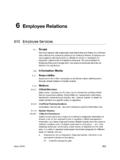Transcription of Youth Leadership Development Curriculum
1 1 Youth Leadership Development Curriculum Facilitator s guide 2 FACILITATOR S guide Introduction Simply put, Leadership Development is an effort that enhances the learner's capacity to lead people. Leading is setting direction and guiding others to follow that direction. A critical skill for leaders is the ability to manage their own learning. As designed, the implementation of the ASPIRA Youth Leadership Development Curriculum (YLDC) will be made possible through the ASPIRA Clubs. As an ASPIRA Club advisor, you will need to facilitate the learning process of our Aspirantes. This Curriculum is structured to assist this process. This Curriculum is provided to enhance your knowledge about Youth Leadership Development .
2 The facilitator is encouraged to review the brief summary of research on the theoretical framework for Youth Leadership Development provided in Appendix A. The Facilitator s guide has been designed to provide an overview of the Curriculum , its goal, objectives and expectations. Overall Goal The goal of the ASPIRA Youth Leadership Development Curriculum is to build resiliency skills, positive identity and self-esteem through a comprehensive positive Youth Development program. This tool seeks to reduce risky behaviors among middle and high school Youth and to prevent them from engaging in risky behaviors in the future. Overall Objectives Participants will develop resiliency skills through their participation in the varied activities. Participants will demonstrate positive attitudinal change regarding school, their peers, and parents, and will have increased their self-esteem as measured through research studies.
3 Cultural Competency The ASPIRA Youth Leadership Development Curriculum is designed to be culturally competent; however, any feedback provided by facilitators and participants will be carefully reviewed and considered in order to enhance its effectiveness. 3 Likewise, the facilitator is expected to be aware and knowledgeable about the population groups in the program and able to conduct activities in a manner that does not only demonstrate understanding of the varied cultures, but also promotes cultural awareness. Role of the Facilitator In implementing the Curriculum , the facilitator plays a very important role. The facilitator will not only facilitate the lessons, but will also attend to participants needs and show support to participants as needed. The facilitator will also maintain a group process that encourages group interaction and fosters interpersonal learning.
4 Professionals in the education field suggest that displaying a positive attitude significantly impacts students learning experiences (Jankowska & Atlay, 2008). The facilitator is encouraged to express enthusiasm and make creative use of space, if possible, incorporate technological tools in the classroom such as using the computer and overhead projector, among others. The facilitator is expected to follow the participants progress, selecting activities appropriate for participants educational and developmental levels. The role of the facilitator is not to lead a series of activities, but to assist participants in reflecting about the activities and their experience in the program. The facilitator assists participants in processing information or looking at the why of a given experience (Miller, 1995).
5 It may be helpful for the facilitators to explain their role to the participants before the execution of the activities so that participants can begin thinking about their expectations. Likewise, the facilitator will need to work with participants in establishing rules and expectations for a successful program. This should be done in a brainstorming session, in which the facilitator takes notes on the blackboard. Involving participants in this process will provide them with a sense of belonging and accountability. Incorporating participants in Establishing Ground Rules also entails that all of the participants play a very important role in the group and that their ideas, thoughts and opinions matter. Role of the Participant The role of the participant is to participate in all activities and to reflect on their learning experiences.
6 They will need to abide by the rules and meet the expectations as future leaders. Among the expectations are: 4 o Confidentiality: Participants are expected to maintain the integrity of the group by keeping things to themselves and not disclosing what is discussed in the groups out of the classroom. o Respect: Participants are expected to respect each other s opinions, which include allowing each other to express their views and concerns. Curriculum Structure The Curriculum is arranged into eleven units. All units have modules followed by activities. Each module is intended to represent a workshop. Note that each unit contains a course description, followed by goals, and resources needed. Make sure to tell participants what the goals are for each activity. These goals are stated in Table I.
7 Table I: Units Goals I: Overview of ASPIRA Participants will develop knowledge of ASPIRA s mission, vision and history and the ASPIRA Process. Participants will also understand the importance of ASPIRA in the Development of the Puerto Rican and Latino community. The overall aim is that Youth will use ASPIRA s principles as a guide for their future actions and Development . II: ASPIRA Clubs Participants will develop knowledge of ASPIRA Clubs, and the responsibilities of club officers. The overall aim is that students will use ASPIRA s AAA Process as a tool in their future Development . III: Personal Growth Participants will develop knowledge of self and others in order to prepare for effective Leadership through the exposure to a series of activities that promote healthy self esteem, identity, cultural awareness, Development of critical thinking, communication, and organizational 5 skills.
8 IV: Building Resiliency Youth will develop resiliency skills through participation in workshops on gangs, bullying and Youth violence prevention. This course promotes child-parent communication and emphasizes self-responsibility. V: Leadership Development Youth will learn the basic concepts of Leadership Development . They will learn the concept of Leadership and will understand what it means to be a leader. They will also learn different models and theories of Leadership . VI: Academic Success Participants will learn how to plan their academic studies in order to have successful academic performance in preparation for postsecondary education. In addition, they will learn about the college application process and opportunities for paying for college. VII: Career Awareness Participants will become familiar with career research and paths to careers.
9 They will also apply their decision-making skills to career selection. VIII: Community Involvement Youth will learn the basic concepts of community and community history. They will also examine the influence of culture on community and will have an opportunity to develop and implement a community service project. IX: Cultural Awareness Participants will develop knowledge and awareness about the Latino culture. They will be able to define culture and race. Participants will also develop consciousness of issues related to diversity, such as inclusion, cultural appreciation, prejudice, racism, and stereotyping. X: Public Policy and Leadership Participants will learn about the public policy process, while developing their Leadership skills that will facilitate their involvement in the policy arena at the local, regional, and national levels.
10 Students will define public 6 policy and study policy-making structures. Students will become more acquainted with their community, and the public policy issues affecting it. They will be provided with applications of policy Development for influencing public policy. XI: Financial Literacy Youth will learn the basics of financial literacy and personal finance. They will learn the concepts of banking services and will understand what it means to have a successful financial plan. Curriculum Timeframe The Curriculum was designed to be implemented during a period of four years or levels starting with ASPIRA ntes at middle school or ninth grade. Note that on Table II for each of the activities we have assigned a level and a name to each of the levels following the Taino culture theme.



